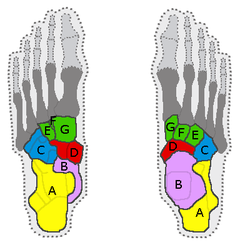Tarsus (skeleton)
| Tarsus | |
|---|---|

Right foot bones
seen from below (Left) and seen from above (Right) 7 bones constituting the tarsus. A - Calcaneus. B - Talus. C - Cuboid. D - Navicular. E, F, G - Cuneiform bones |
|

Bones constituting the tarsus.
Calcaneus Talus bone |
|
| Details | |
| Identifiers | |
| Latin | ossa tarsi |
| TA | A02.5.09.001 |
| FMA | 24491 |
|
Anatomical terminology
[]
|
|
Calcaneus Talus bone
Cuboid bone Navicular bone
In tetrapods, the tarsus is a cluster of seven articulating bones in each foot situated between the lower end of tibia and fibula of the lower leg and the metatarsus. The tarsus articulates with the bones of the metatarsus, which in turn articulate with the proximal phalanges of the toes. The joint between the tibia and fibula above and the tarsus below is referred to as the ankle joint.
In humans the largest bone in the tarsus is the calcaneus, which is the weight-bearing bone within the heel of the foot.
The talus bone or ankle bone is connected superiorly to the two bones of the lower leg, the tibia and fibula, to form the ankle joint or talocrural joint; inferiorly, at the subtalar joint, to the calcaneus or heel bone. Together, the talus and calcaneus form the hindfoot.
The five irregular bones of the midfoot—the cuboid, navicular, and three cuneiform bones—form the arches of the foot which serves as a shock absorber. The midfoot is connected to the hind- and forefoot by muscles and the plantar fascia.
...
Wikipedia
